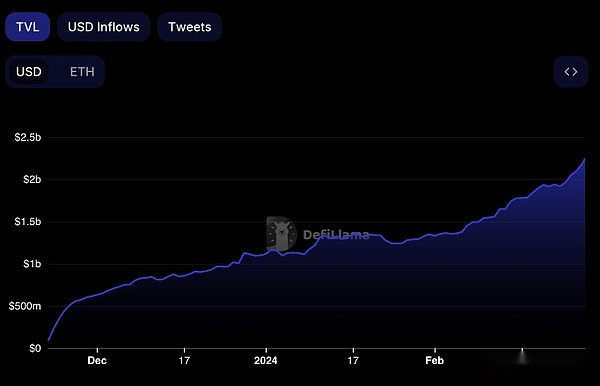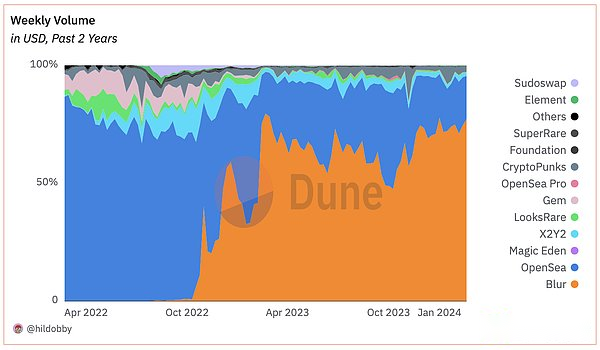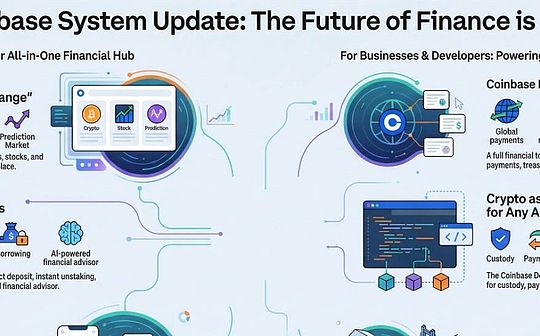
Author: David C, Bankless; Compilation: Deng Tong, Bit Chain Vision
Since BLAST announced the raising $ 20 million in funds in November last year, the cryptocurrency community has always questioned how it can prove that it can support a project that is so enthusiastic about attracting funds.Essence
Three months have passed. Unsurprisingly, cryptocurrencies seem to be satisfied with the TVL of more than $ 2 billion to explain everything.
Today, the main network of BLAST network is unveiled.The biggest question is, can they build a sustainable network through long -term efforts?
Although the BLAST event in the next few weeks should let us understand the level of L2 demand, the real test will come in May, and BLAST will be able to receive airdrops.Although only time can prove everything, the strategy used to check BLAST has so far, the performance of Blur project, and the potential benefits of native yields may allow us to understand the future of the blockchain.

What makes BLAST different?
Blast’s innovation lies not only in its technical function, but also the strategy before its release.From the beginning, BLAST has cultivated a unique user habit. Only when people receive a recommendation code, they are allowed to communicate -give the entire experience aExclusive feelingEssence
Many people call “Ponz Economics” incorporate this recommendation system,Users can earn a certain percentage of points obtained by the invited person through the bridge ETH or stable coins.It turns out that this strategy is successful.For more than a month, they accumulated more than $ 1 billion of TVL, and BLAST used it as an incentive measure to attract developers to participate in the Big Bang competition.
Big Bang Competition
The developer -centered competition lasted from January 16 to February 18th, and a total of 3,000 projects raced to become one of the first projects released on the main network.
The competition provides a lot of opportunities for TVL accumulated in BLAST, a large number of upcoming airdrops, and direct and continuous support from Blast investors and operators.
Of the 47 winners announced last Friday, many people chose to allocate all the upcoming airdrops to users, trying to “forward” and attract further attention.Although these projects sacrificed potential airdrop rewards, they inspire user activities through airdrops. The project will profit from BLAST’s native income and GAS fees sharing. They obviously think that this is a more favorable pursuit.
Native income and GAS cost sharing
Blast’s native income and GAS cost sharing function can be said to be its most significant feature.
By integrated with Lido and MakerDao at the back end, BLAST provides 4% and 5% annualized income for ETH and stable coins, respectively, Any position on the chain.
BLAST also shared the net income from GAS fees with the DAPP generated by these costs, providing developers with another source of revenue that can be available.The integration of this incentive measure makes L2 a place where users store funds and developers earn income from the contribution of smart contracts.
Between its initial release strategies and unique technical functions, Blast showed some prominent functions to make it different from any other blockchain we have ever seen.
However, the problem still exists, is this enough to continue running after the airdrop?
Will Blast maintain momentum?
We will understand the needs of BLAST in the next few weeks, but by checking the trajectory after Blur airdrops and in -depth research, we can better understand whether the network continues to exist by the native income and GAS fees sharing implementation.
Blur and its airdrop
The development trajectory of the NFT trading platform BLUR, also founded by Pacman in the airdrop.It marks the promise of Blast.
After the first airdrop, Blur did go through the weekly decline in transaction volume, thinking that this was the downturn of the entire NFT market, and the market bottomed out in October 2023.Since then, Blur’s market share has not only resumed, but also increased.The platform currently accounts for about 77%of the weekly transaction volume. Even after Blur launched the second airdrop last in November last year, this number continued to grow.

Although it cannot avoid the influence of market dynamics, Blur’s innovative incentive plan makes senior users active on the platform, and a large number of airdrops often only attract more people’s attention to the platform.
BLAST also uses similar incentive structure innovation methods, that is, retaining and attracting users with new mechanisms such as native income and GAS cost sharing, which also shows the strategy used by Blur.
Examples of native income and GAS fee sharing
Although 4-5% of the yields and GAS costs seem to be not much at first,BLAST’s native yield and GAS cost sharing achieved unique cases and business models that were impossible or inaccurate in the past.
Take a few examples and look at Monoswap and Blastoff.
Monoswap is a new DEX on BLAST. It uses native income to provide points with practical uses, not just exchange tokens.For the operation on its platform, users will receive Monoxp (their points) to provide them with unique rewards and privileges -such as being able to share the revenue of the machine, GAS revenue sharing, developer airdrop distribution, Mono ecologyThe overall profit of the system.Through this, Monoxp shows an attempt to closely combine users and platforms, use points in a novel way, and further gamize DEFI experience.
Next, the startup board and the income polymer Blastoff played the revenue in a novel way through the Native Yield IDO.On their platforms, users who pledge ETH and stable coins can choose to allocate some income to support IDOs, combining passive income with early investment opportunities without the need to risk the principal.These two platforms jointly show the use cases that can only be achieved through this machine, which can provide BLAST’s lasting power.
in conclusion
Blast’s first appearance from the controversial debut to the main network release is undoubtedly very interesting.
By combining pre -release strategies with controversy (but noticeable!), BLAST has attracted a large number of followers.Compared with Blur airdrops, and novel cases brought about by native income and GAS fees sharing, it further consolidates the argument of BLAST’s continuing correlation.
Under the common effect of all these forces, it is clear that BLAST has placed itself in an enviable position, flourishing in this new bull market, and the use of its products and communities to promise to stand out among many new upstart L2.







